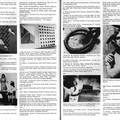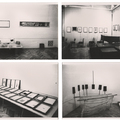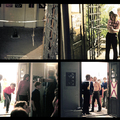Folder nr. V-156455 ("Schwitters") pp 103-113
Ministry of Interior, Chief Directorate III,
Directorate III, Subdivision 2/b
Strictly Confidential
[Stamp: copy of the original document held at the Historical Office]
Re: code name: „Schwitters”
SUMMARISING REPORT AND ACTION PLAN
On 25 June 1966, the first Hungarian happening took place in Budapest. The English word happening stands for some kind of an event. The movement developed in the 20s and 30s of the 20th century and can be traced back to the Futurist and Dadaist initiatives as known from fine arts and literature. Prominent figures include the Italian Marinetti, the French Salvador Dali and the German Schwitters. For the latter, every object, even pieces of urban waste – from tram tickets to discarded magazine cut-outs, bent nails, and rotting pieces of wood – constituted utilisable components of art, of even documental value. Schwitters even perceived garbage as a usable tool and symbol of expression.
The concept of happening was brought to Hungary from Europe by László Moholy (an architect of Hungarian origin). One of its most famous representatives there is Robert Rauschenberg, founder of the Odds and Ends from the Garbage Dump Theater in New York. There are a number of different happenings in the United States today: purely fine art, musical, and what tends more towards the theatrical. In Hungary, the latter has been introduced. A happening is a play without a pre-written script. The performers do whatever they think of while acting – in other words, they improvise. The aim is to inspire the audience to similarly engaged activities.
The American Alan Ginsberg defines the objective of a happening as “… subjection to the logic of a hectic world, in other words, participants renounce their illusory right to influence chance events and admit to the fact of their complete defenselessness all the way down to physical annihilation.”
A happening, as regards its philosophical aspect, is a declaration of nihilism, darkness, irrationalism and the denial of healthy human activity. Its religion is aggression and hysteria. Its practical realisation serves the purpose of scandalising the public and asserting exaggerated decadence. Its U.S. variant, in its final stage, lead to a torrent of violence, mass drug abuse and open clashes with the police.
Of the socialist countries, happenings have become most widespread, and have received the most press coverage, in Poland.
Happenings in the west can be regarded as gestures for scandalising the public and pastimes for killing boredom. In Hungary, it can be regarded as a turning away from active-constructive activity, and, thus, facilitating for the politics of subversive decentralisation. For example, on the first page of the February 1968 issue of the “Press Review” – a Hamburg-edited publication, featuring original articles from German papers and regularly sent to our universities from West Germany with imperialistic aims – an article was presented by the title “Harbinger of Happening”.
Based on information we have gathered, happenings have been organised in Budapest in the following locations:
1. The first one was held on 25 June 1966 at 4 PM in the basement of István Szenes at 20/b Hegyalja Avenue, 1st District, Budapest. Previously the event was planned to be held in the flat of XXXX (editor of XXXX), who supported the initiative, but, after acquiring additional information decided out of precaution not to allow this.
The first happening was organised by: Gábor Altorjay, XXXX, academy student and Tamás Szentjóby, XXXX, address: XXXX.
The literature came from Béla Arany, who is employed by Kultura – Hungarian Trading Company. He found a foreign book there, which described happenings with photo illustration.
Although 150 invitations were sent out for the event, only 50-60 people turned up. The printing of the invitations was organised by the aforementioned Károly Dorombi. The list of invitees was compiled by Szentjóby and Altorjay. Most of the invitees were university graduates, including poets, journalists, painters, engineers, etc. The group mostly consisted of the friends of Pál Petrigalla and Dr. László Végh from various art circles and clubs as well as inner-city acquaintances of Gábor Altorjay and Tamás Szentjóby.
An entrance fee of 10 Ft per person was collected. When the signal was given, the audience moved to the garden in the back, where, at the entrance of a very old basement, a half-naked Szentjóby dug waist-deep in the earth wearing a green sunshade was typing onto a sheet of newspaper. A cat tail, which was attached with string to the typewriter, was dangling into a pot of paint. In the background, a gasoline-drenched baby carriage was in flames. A few of the wooden stairs leading to the basement had been removed and there was no lighting – these
were the circumstances in which the audience were to make their descent. Downstairs, in the darkness, Stockhausen’s electronic piece entitled “Victory” suddenly sounded. The first two movements were played, whose first part consists of the sounds of an airstrike mixed with incoherent conversation fragments from a French group in an air-raid shelter that has been buried underground.
After the light was switched on, a kitchen table could be seen in the background with two people sitting next to it. Behind them, a third person was busying himself with a chicken tied to a red pot. While eating, they occasionally let out a great belch, amplified for the audience with the help of a microphone and speakers. When they finished lunch, a large plastic bag was produced into which one of the participants vomited the contents of his stomach.
Next, they retrieved a black handbag from an old refrigerator, which they handed to the audience. This contained white mice. Then they grabbed some hammers and shattered the plates, the table and the chairs. The third participant was tied to the doorframe. In a bowl they mixed water and lime and poured it on the clothes of the tied person, and then they also smeared a tube of toothpaste on his clothing. The feathers from a torn up duvet were poured partly on the tied up person and partly on the audience. A condom was filled with some kind of sticky, red material, and then hung up with a candle lit under it. The cassette player was switched on and distorted music could be heard. Then one of the participants tied a string around the room in a spider web-like fashion, went back to the middle and smashed the light bulb with a thermos. In the meantime, someone had blocked the basement entrance so exiting was slow to start.
In response to what took place, Dr. Végh announced that he was going to organise an anti-happening, because he didn’t like when someone was trying to introduce order into anarchy. Many of the viewers liked the idea, others were more careful to express their opinion. The audience generally expressed appreciation for what they had seen; they were afraid to object, lest they be regarded as conservative and opposed to novelty.
László Kamondy wrote an article about the first Hungarian happening with the title “Lunch In Memoriam Batu Khan; Meditation on the First Hungarian Happening”, which was featured in the 13 September 1966 issue of the weekly publication Tükör and supplemented with photos of the event by Gyula Zaránd. In addition, Esti Hírlap and Népszava also published short articles in reference to the happening.
2. The second happening was initiated and presented by Gábor Altorjay with the title “Golden Sunday” on 27 December 1967. Szilárd Rubin (address: XXXX) offered his own flat as the venue for the show, but when he found out that approx. 100 people were to be invited, he backed out. The happening was held in the coal cellar of Miklós Erdélyi. Altorjay sent invitations to 50 people, but only 18 people attended.
3. Happenings were held at the University Stage on two occasions within the framework of the “Horizon” show. This program is edited by journalist György Horváth, but Péter Vágó also assisted in the editing work.
The happening was held on 18 January 1968 by Tamás Szentjóby and György Lendvai. Prior to the show, a lecture was given with the title “The Influence of Zen Buddhism on American Literature”. Then György Horváth gave an introduction in which he explained the concept of the happening and read relevant excerpts from Polish magazines.
4. On 20 February 1968, at the club of the Transport Catering Company (Budapest, 5th District, Arany János Street), a pop art evening was held with the title “Hidden Parameters”, organised by István Poór. As part of the program, Miklós Erdélyi (one of the ideological founders and enthusiastic organisers of Hungarian happenings) gave a lecture about the happening phenomenon. This was followed by an improvised happening performed by Tamás Szentjóby.
According to network reports, in the evening of 27 March 1968 István Poór, Miklós Erdélyi
and Tamás Szentjóby convened in Kárpátia, to discuss the possibility of organising a new, larger-scale happening.
They agreed that the organiser and presenter of the show was going to be István Poór. Miklós Erdélyi was to provide adequate ideology for it, and, if needed supply the editors of the show with further samples of foreign literature. The harmonic and artistic realisation of the happening was to be the responsibility of Tamás Szentjóby. They are planning their next meeting for 6 April 1968, whereby they will try to work out further details of the show. Poór noted that the greatest problem was the security of the space in question. XXXX During the discussion, István Poór also mentioned that lately the police had caught scent of the word happening, and the shows themselves. The police were allergic to happenings; they would immediately become agitated upon hearing this word and do anything to stop the events. For this reason, in the future, use of the word happening was to be avoided, and, instead op art, pop art or other words were to be used.
Action Plan
Based on the above, it can be stated that the spreading of the happening phenomenon is harmful to the intellectual and political development of youth. Furthermore, it is an occurrence that goes against progress and facilitates the decentralising politics of imperialist circles.
- In order to decrease its harmful effects on today’s youth, the spreading of happenings must be prevented.
- The key organising figures of Hungarian happenings, as well as their possible foreign contacts, must be placed under surveillance.
- By way of open administrative and operative means the main circles of the organisers must be broken up.
- Public appearances by the organisers of happenings must be prevented. It must be made impossible for them to use public forums for spreading and popularising the happening phenomenon.
In order to realise the abovementioned tasks, the following specific measures are
recommended:
1. According to previous conversations with the person in charge of the University Stage (Zoltán Rózsa, director), he also disapproves of happenings. In his opinion, there is no place for such shows at the University Stage.
Director Rózsa is once again to be sought out and pressed to implement his views in practice as well.
Deadline: [handwritten date - illegible]
In charge: XXXX
- Similar action to inform the Communist Youth Association and party leadership of the Humanities Department of the Eötvös Lóránd University (ELTE), as a preventive measure.
Deadline: [handwritten date - illegible]
In charge: XXXX
- Informing the Election Committee of the Communist Youth Association at ELTE and the management of the Eötvös Club so that the happening is not allowed to take place in the Club.
Deadline: 30 May 1968
In charge: Lieutenant XXXX
2. Signal to the Ministry of Culture and the Culture Bureau at the Budapest City Council, in agreement with Division III/III/4, that they are not to give permission for “happening” events.
In charge: XXXX
Deadline: 30 May 1968
3. Signal to Chief Directorate II that, upon receiving a request for a “happening”, they are to refuse signing it.
Deadline: 30 May 1968
In charge: XXXX
4. An action plan is to be worked out for breaking up happenings from within the movement. In accordance with the information gathered thus far, the conceptual opposition regarding the question of happenings between Tibor Frankl and Tamás Szentjóby can be taken advantage of to this effect. The centralised control and harmonisation of network persons in contact with happening organisers should be worked out jointly with Subdivision III/III/4-a.
Deadline:
In charge: [handwritten date - illegible]
5. The known persons are to be kept under surveillance by the Passport Bureau. They must be placed under “K” monitoring.
Deadline: XXXX
In charge: [handwritten date - illegible]
6. The main organisers of happenings must be warned against involvement in future happenings, with special regard to Tamás Szentjóby, who is the most active person in this respect. Szentjóby is to be told that if he does not refrain from organising such events in the future, a recommendation will be made for his treatment in a mental institution.
Deadline: 30 June 1968
In charge: Budapest Police Headquarters, Political Bureau, Subdivision III
7. The legal possibilities for referring Tamás Szentjóby to a mental institution must be explored. Under justified circumstances, appropriate measures are to be taken for his removal to this effect.
Deadline: ongoing
In charge: Budapest Police Headquarters, Political Bureau, Subdivision III
8. Agent of the alias “László” is to travel to Czechoslovakia and Poland in order to terminate the illegal channels of related to happenings.
Deadline: 15 May 1968
In charge: Captain XXXX
9. As far as we are aware, the following are those network persons who have submitted reports re. happenings, who have connections to the organisers of happenings, and through whom network monitoring can be facilitated.
a. Informant of the alias “Mészáros” has provided a detailed report regarding the first happening and has means of acquiring information in connection to the main organisers of the happening. He can continue to be used for monitoring purposes.
Deadline: ongoing
In charge: Lieutenant XXXX
b. Agent of the alias “László” has provided a number of reports in reference to the happenings. He has the best means of gathering information about the main organisers.
Deadline: ongoing
In charge: Captain XXXX
c. Agent of the alias “Hajdu”, who was among the invitees of the first happening, has certain means of acquiring information about the organisers of the happenings.
Deadline: ongoing
In charge: Lieutenant Colonel XXXX
III/III/1-b
d. Informant of the alias “Tibor Kurucz”, through István Poór, has means of acquiring information in reference to the latest plans for organising happenings.
Deadline: ongoing
In charge: Lieutenant XXXX
e. Informant of the alias “György Fung” has provided a report in reference to the organisation of the latest happening. He has the means to report on happenings through István Poór.
Deadline: ongoing
In charge: Lieutenant XXXX
f. Agent with the alias “Bárány” has provided a report in reference to Sándor Török Sztaskó (Czechoslovakian citizen) and his connection to the organisers of the happenings. He has means of acquiring information in this direction.
Deadline: ongoing
In charge: Captain XXXX
Budapest Police Headquarters, Political Bureau, Subdivision III/b
10. Elaboration of a new action plan based on implemented operative measures, incoming network reports and information acquired through other means.
Deadline: 30 September 1960
In charge: Budapest Police Headquarters, Political Bureau, Subdivision III [entire entry crossed out by hand]
Note:
Contacts at the Central Divisions of the Ministry of Interior must be alerted: should they come across any reports regarding happenings, they should inform the subdivision assigned to the case immediately.
Budapest, 11 May 1968
[Signature 1 – crossed out; Police Lieutenant XXXX
Signature 2 – crossed out; Police Lieutenant XXXX]
Made in three copies.
Registration No. 2-7-338
Appendix
for summarising report, code name “Schwitters”.
In accordance with data gathered thus far, individuals by the following names were invited to the first Hungarian happening held on 25 June 1966 in the basement of István Szenes (Budapest, 20/b Hegyalja Street):
1. Dr. László Végh physician, composer
2. Miklós Erdélyi architect
3. Szilárd Rubin writer, journalist
4. István Szenes interior designer
5. Károly Doromby journalist
6. Sándor Molnár abstract painter
7. János Herskó film director
8. Sándor Weöres poet
9. János Pilinszky poet
10. Krisztina Pasuth art historian
11. Gyula Zoránd press photographer (Tükör)
12. László Kamondy journalist
13. Csaba Koncz photographer
14. János Kenedy
15. János Sterliczky
16. Pál Petrigalla
17. István Ventalin J
18. László Benke
19. Tibor Sörös
20. Elemér Zalotai
21. Béla Hamvas
22. Miklós Szentkuti
23. boy by the name of Ungvári
24. girl by the name of Gladys
In accordance with our data, of the above mentioned persons, Sándor Weöres, János Pilinszky, Béla Hamvas and Miklós Szentkuti did not attend the happening. As regards the rest of the invitees, we have no information.
According to the confession of Gábor Altorjai, the following persons appeared at the second happening held on 27 December 1967:
Géza Porneczky art historian
Szilárd Rubin writer, journalist
Péter Doromby university student
Károly Doromby journalist, literary editor
Miklós Erdélyi architect
Zsuzsa Ferda film director
Arnold Gross painter
Miklós Jankovich shop assistant
Ania Kowalska Polish citizen
Gábor Altorjay academy student
Gyula Konkoly painter
Éva Nádasdi poet, teacher
Tamás Szentjóby poet
Antal Dul academy student
Gyula Zaránd press photographer, journalist (Tükör)
Gitta ... pantomime artist
Dr. László Végh physician, composer
Total of 18 persons
Budapest, 11 May 1968
Traslation: Zsófia Rudnay

 tranzit is a contemporary art program supported by the Erste Bank Group
tranzit is a contemporary art program supported by the Erste Bank Group

 The exhibition Parallel Chronologies and the symposium The Invisible
History of Exhibitions is part of the international project Art Always Has
Its Consequences co-financed by the Culture 2007 program of the European
Union (partners: WHW Zagreb, tranzit. hu, Muzeum Sztuki Łódź, kuda.org
Novi Sad).
The exhibition Parallel Chronologies and the symposium The Invisible
History of Exhibitions is part of the international project Art Always Has
Its Consequences co-financed by the Culture 2007 program of the European
Union (partners: WHW Zagreb, tranzit. hu, Muzeum Sztuki Łódź, kuda.org
Novi Sad).








Utolsó kommentek